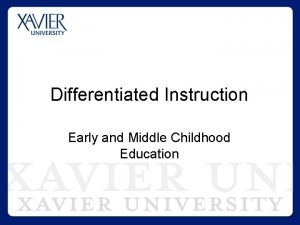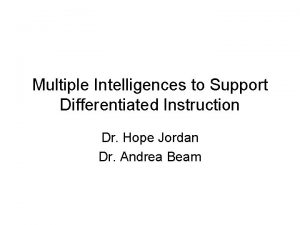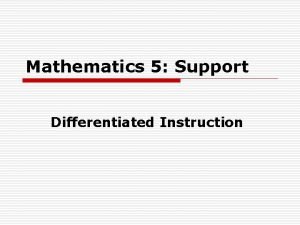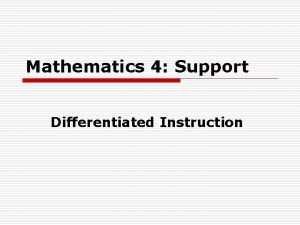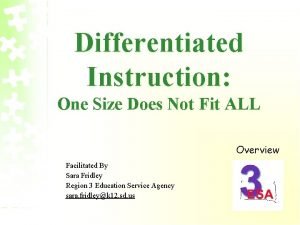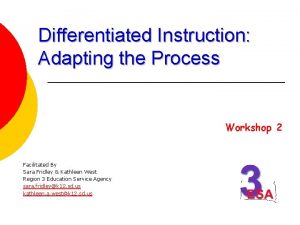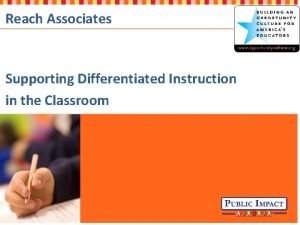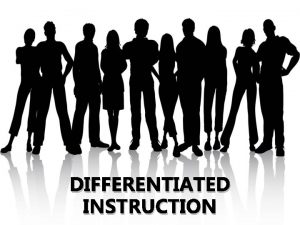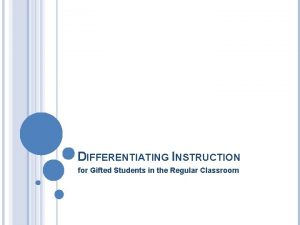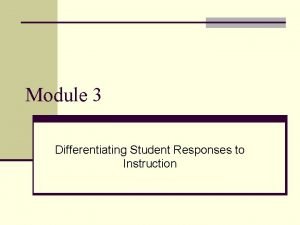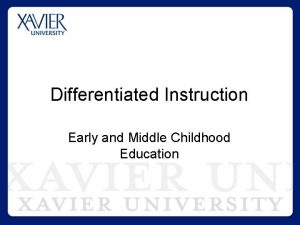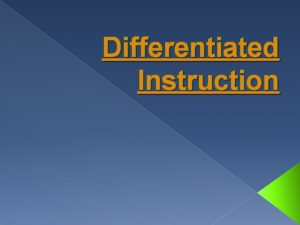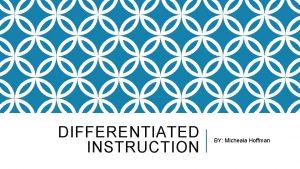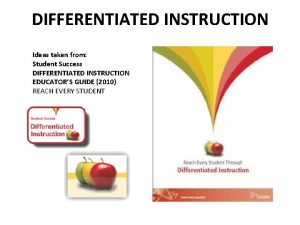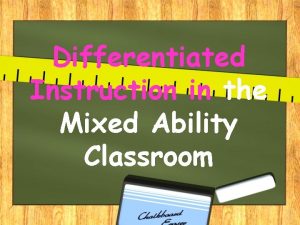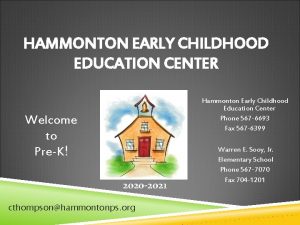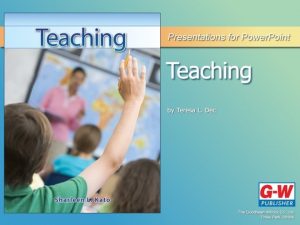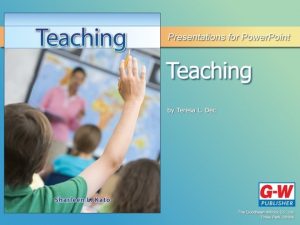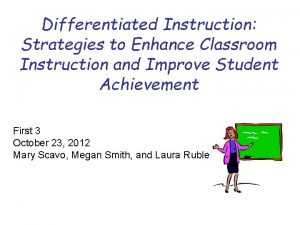Differentiated Instruction Early and Middle Childhood Education What















- Slides: 15

Differentiated Instruction Early and Middle Childhood Education

What is Differentiated Instruction? • There are multiple pathways for learning. • Students vary in many ways. Their interest, motivation, background knowledge, prior experiences, culture and language proficiency as well as their intellectual capabilities. • It is important to adapt instruction to take these differences into account. » Tompkins, 2013, p. 41

What is Differentiated Instruction? • Tomlinson (2000) states, “at its most basic level, differentiation consists of the efforts of teachers to respond to variance among learners in the classroom. • Whenever a teacher reaches out to an individual or small group to vary his or her teaching in order to create the best learning experience possible, that teacher is differentiating instruction.

Differentiation is a Step in the Larger Systemic Pedagogical Data Collection Process Developmentally Appropriate Practices • engaging, integrated, formative instructional strategies Differentiation • Content • Process • Assessment • Products • Learning Environment • DATA COLLECTED Academic Intervention • Systematic, targeted, intervention to support an individual in an academic skill area. • DATA COLLECTED

What it is not…… • Differentiation is not individualized instruction. • It is not the equivalent to IEP mandated individualized instruction. • A permanent instructional strategy for an individual or group of students, over a long period of time.

How to Differentiate Instruction • Consider the following broad principles as you think about how to differentiate your lessons: – Assessment as ongoing and tightly linked to instruction – Respectful activities for all students are a part of classroom instruction – Flexible grouping part of planning for classroom instruction

How to Differentiate Instruction • Differentiating instruction means changing up what goes on in the classroom so that students have multiple options for learning. This can include choice, small group work, centers, and projects. • Specifically, teachers can differentiate instruction through four classroom elements that are based on student readiness, interests, or learning needs.

How to Differentiate Instruction Content Teachers can differentiate the content by: Ø Using reading material at varying readability levels Ø Putting text materials on tape Ø Using vocabulary lists at readiness levels Ø Presenting ideas through both auditory and visual means

How to Differentiate Instruction Ø Ø Process Provide interest centers that encourage students to explore subsets of the topic Develop personal agendas Offer manipulatives or other hands-on supports Vary the length of time a students may take to complete a task

How to Differentiate Instruction Ø Ø Products Give students options of how to express required learning Use rubrics that match and extend students’ varied skill levels Offer students the option to work alone or in a small group or with a partner Encourage students to create their own product

How to Differentiate Instruction Assessment • Provide multiple ways for student to ‘show what they know’ • Select assessments that include options for how your students will “show you what they know” • Provide both formal and informal assessment options

How to Differentiate Instruction Learning Environment Ø Provide areas for students to work quietly or in collaboration Ø Provide guidelines for individual work Ø Establish effective classroom routines Ø Provide materials that reflect a variety of cultures and home settings

How to Differentiate Instruction • There are no recipes for differentiating instruction. • Consider the following guidelines as you differentiate your instruction in your lesson plans: – Reflect on your students and plan instruction that meets their learning needs – Review the classroom management routines – After your lessons, thinking about and reflect on your students’ understanding of your objectives and the instruction you provided. – Review your assessment measures

Why Differentiating Instruction is Important • Students vary greatly and teachers need to maximize their potential and translates this knowledge into classroom practice • Differentiating instruction provides a way of thinking about teaching that values students’ needs and learning styles

Differentiating Instruction • Resources – Tomlinson, C. (2000). Differentiation of instruction in the elementary grades. Eric Digest. EDO-PS-00 -7. – Tompkins, G. (2013). Patterns of Practice. Boston, MA: Pearson.
 Early childhood development with differentiated instruction
Early childhood development with differentiated instruction Middle
Middle Differentiated instruction vs individualized instruction
Differentiated instruction vs individualized instruction Multiple intelligences and differentiated instruction
Multiple intelligences and differentiated instruction Entry points differentiated instruction
Entry points differentiated instruction Entry points differentiated instruction
Entry points differentiated instruction Think dots differentiated instruction
Think dots differentiated instruction Think dots differentiated instruction
Think dots differentiated instruction Jigsaw differentiated instruction
Jigsaw differentiated instruction Ascd differentiated instruction
Ascd differentiated instruction Differentiated instruction for gifted students
Differentiated instruction for gifted students Jigsaw differentiated instruction
Jigsaw differentiated instruction Pdp early childhood education and training program
Pdp early childhood education and training program Early childhood directorate
Early childhood directorate Trends in early childhood education
Trends in early childhood education Early childhood education in pakistan
Early childhood education in pakistan
